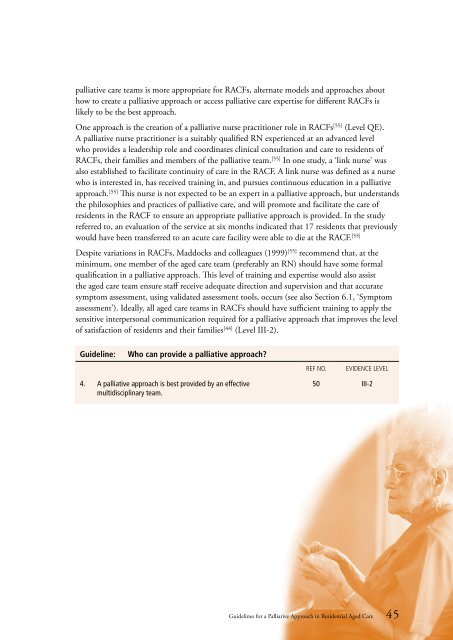Guidelines for a Palliative Approach in Residential Aged Care
Guidelines for a Palliative Approach in Residential Aged Care
Guidelines for a Palliative Approach in Residential Aged Care
Create successful ePaper yourself
Turn your PDF publications into a flip-book with our unique Google optimized e-Paper software.
palliative care teams is more appropriate <strong>for</strong> RACFs, alternate models and approaches about<br />
how to create a palliative approach or access palliative care expertise <strong>for</strong> different RACFs is<br />
likely to be the best approach.<br />
One approach is the creation of a palliative nurse practitioner role <strong>in</strong> RACFs [55] (Level QE).<br />
A palliative nurse practitioner is a suitably qualified RN experienced at an advanced level<br />
who provides a leadership role and coord<strong>in</strong>ates cl<strong>in</strong>ical consultation and care to residents of<br />
RACFs, their families and members of the palliative team. [55] In one study, a ‘l<strong>in</strong>k nurse’ was<br />
also established to facilitate cont<strong>in</strong>uity of care <strong>in</strong> the RACF. A l<strong>in</strong>k nurse was def<strong>in</strong>ed as a nurse<br />
who is <strong>in</strong>terested <strong>in</strong>, has received tra<strong>in</strong><strong>in</strong>g <strong>in</strong>, and pursues cont<strong>in</strong>uous education <strong>in</strong> a palliative<br />
approach. [55] This nurse is not expected to be an expert <strong>in</strong> a palliative approach, but understands<br />
the philosophies and practices of palliative care, and will promote and facilitate the care of<br />
residents <strong>in</strong> the RACF to ensure an appropriate palliative approach is provided. In the study<br />
referred to, an evaluation of the service at six months <strong>in</strong>dicated that 17 residents that previously<br />
would have been transferred to an acute care facility were able to die at the RACF. [55]<br />
Despite variations <strong>in</strong> RACFs, Maddocks and colleagues (1999) [55] recommend that, at the<br />
m<strong>in</strong>imum, one member of the aged care team (preferably an RN) should have some <strong>for</strong>mal<br />
qualification <strong>in</strong> a palliative approach. This level of tra<strong>in</strong><strong>in</strong>g and expertise would also assist<br />
the aged care team ensure staff receive adequate direction and supervision and that accurate<br />
symptom assessment, us<strong>in</strong>g validated assessment tools, occurs (see also Section 6.1, ‘Symptom<br />
assessment’). Ideally, all aged care teams <strong>in</strong> RACFs should have sufficient tra<strong>in</strong><strong>in</strong>g to apply the<br />
sensitive <strong>in</strong>terpersonal communication required <strong>for</strong> a palliative approach that improves the level<br />
of satisfaction of residents and their families [44] (Level III-2).<br />
Guidel<strong>in</strong>e:<br />
Who can provide a palliative approach?<br />
Ref No.<br />
Evidence level<br />
4. A palliative approach is best provided by an effective<br />
multidiscipl<strong>in</strong>ary team.<br />
50 III-2<br />
<strong>Guidel<strong>in</strong>es</strong> <strong>for</strong> a <strong>Palliative</strong> <strong>Approach</strong> <strong>in</strong> <strong>Residential</strong> <strong>Aged</strong> <strong>Care</strong> 45
















